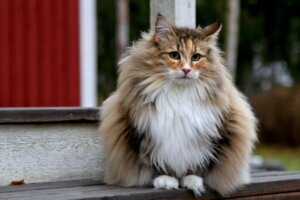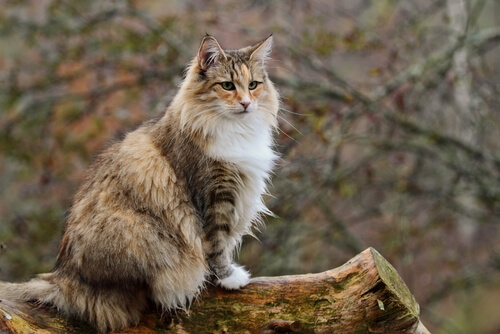13 Fun Facts About the Norwegian Forest Cat


Written and verified by the psychologist Sara González Juárez
Sometimes the best way to learn about breeds is through fun facts, as in the case of the Norwegian Forest cat. Related to the Maine Coon and the Siberian cat, these domestic felines are an incredible companion with their sociable nature and their strength of character.
In this article, we’ll tell you 13 curiosities that you’re sure to enjoy. Don’t miss anything, because these cats were already traveling with the Vikings on their voyages, thousands of years ago.
1. The Norwegian Forest cat

In their country of origin, Norway (as their name suggests), they’re known as nors skogkatt, “forest cat”. Before being domesticated, these felines were spotted in forests and mountains, feeding on small animals and hunting them with surgical precision. Whether in trees or on steep rocks, they always seem to be at home.
2. They’re excellent climbers
In connection with the above, it’s necessary to emphasize the great ability of the Norwegian Forest cat to climb the most impossible places. And the fact is that this breed has longer paws than usual for a domestic cat, which allows them to walk on snow without sinking and to climb more easily.
3. In the mix is the excellence
The Norwegian forest that is known today isn’t the same as the one that accompanied the Vikings on their ships to control rodent populations. It seems that they are a mixture of short-haired cats native to Norway and the long-haired cats that the British transported to Scandinavia. This mixture was later crossed with wild and domestic cats, giving rise to the breed as we know it today.
4. Their long coat isn’t the only thing that keeps them warm
It’s easy to think that the Norwegian Forest cat’s long coat is its only coat, but this isn’t the only thing that keeps it warm. With only one coat, it wouldn’t be able to withstand the sub-zero temperatures that are reached in winter and at night in its place of origin. For this purpose, it has two coats – a shorter, inner one and a longer outer one. In this way, air is more easily trapped between the hairs, and less body heat is lost.
5. A robust breed
Although the Norwegian forest breed is typified and has undergone a process of selective breeding by man, it has quite robust genetics. The only congenital problem they suffer from is hypertrophic cardiomyopathy, but otherwise they usually enjoy good health.
6. As big as their reputation
Maybe you can’t tell from the pictures, but this is a very large breed. While males can grow to 5-7 kilograms (11 to 15 lbs), even 9 (20 lbs) females range from 4-5 kilograms (9-11 lbs). It’s important to keep this in mind when adopting one, as their space and handling requirements will not be the same as other domestic felines.
7. Another fun fact about the Norwegian forest cat: its character
Despite being animals with a strong and independent character, they also create strong bonds with their humans. In addition, they tend to be friendly to strangers as well, welcoming them home.
8. Not the best breed for children
Because this breed is so independent, it isn’t recommended for small children. It isn’t an aggressive breed, quite the contrary. However, going beyond its limits or disrespecting them usually ends badly for both parties. However, by acting with respect and working on socialization it’s possible to have a proper coexistence.
9. You need to look after its coat
An animal with such a mane requires special care when it lives in a human home, especially during the molting season. It will need frequent brushing to avoid dreadlocks and skin problems. If you handle it well, a visit to a specialized pet groomer is also a good idea.
10. They were the cats that pulled Freyja’s chariot
Freyja, the goddess of love, beauty and fertility, according to legend, traveled in a chariot pulled by these cats when she marched to war. Part of the duality of the Norse gods was based on this, on representing both sides of the same coin. In the case of Freyja, the fact that she possessed a means of traveling (just as Odin rode Sleipnir) highlights her as one of the most important to this mythology.
11. One of the most unknown fun facts about the Norwegian forest cat: they like water
Earlier we talked about the ability of the Norwegian forest cat’s coat to insulate body heat and protect from the cold. In addition, the outer and longest layer of fur is waterproof, which allows this feline to get into the water without getting cold and to dry quickly. This is why a Norwegian forest cat isn’t usually afraid to get in the shower.
12. They’re efficient hunters on land and in water
Thanks to their waterproof fur, they’re able to hunt both on land and in water. This, together with their great climbing ability, makes them all-terrain predators. Whether it’s a small lizard fleeing through rock crevices or a fish camouflaged at the bottom of the river, they”ll have a great chance of catching it.
13. Big cat, little meow

The last of the fun facts about the Norwegian Forest cat is that, despite its large size, it has a very quiet meow. This contrast is usually one of the characteristics most appreciated by humans who welcome them in their homes.
So, did you know any of these fun facts? Undoubtedly, this is one of the most loved breeds around. If you ever get the opportunity to adopt one, don’t hesitate to give this incredible cat a home.
Sometimes the best way to learn about breeds is through fun facts, as in the case of the Norwegian Forest cat. Related to the Maine Coon and the Siberian cat, these domestic felines are an incredible companion with their sociable nature and their strength of character.
In this article, we’ll tell you 13 curiosities that you’re sure to enjoy. Don’t miss anything, because these cats were already traveling with the Vikings on their voyages, thousands of years ago.
1. The Norwegian Forest cat

In their country of origin, Norway (as their name suggests), they’re known as nors skogkatt, “forest cat”. Before being domesticated, these felines were spotted in forests and mountains, feeding on small animals and hunting them with surgical precision. Whether in trees or on steep rocks, they always seem to be at home.
2. They’re excellent climbers
In connection with the above, it’s necessary to emphasize the great ability of the Norwegian Forest cat to climb the most impossible places. And the fact is that this breed has longer paws than usual for a domestic cat, which allows them to walk on snow without sinking and to climb more easily.
3. In the mix is the excellence
The Norwegian forest that is known today isn’t the same as the one that accompanied the Vikings on their ships to control rodent populations. It seems that they are a mixture of short-haired cats native to Norway and the long-haired cats that the British transported to Scandinavia. This mixture was later crossed with wild and domestic cats, giving rise to the breed as we know it today.
4. Their long coat isn’t the only thing that keeps them warm
It’s easy to think that the Norwegian Forest cat’s long coat is its only coat, but this isn’t the only thing that keeps it warm. With only one coat, it wouldn’t be able to withstand the sub-zero temperatures that are reached in winter and at night in its place of origin. For this purpose, it has two coats – a shorter, inner one and a longer outer one. In this way, air is more easily trapped between the hairs, and less body heat is lost.
5. A robust breed
Although the Norwegian forest breed is typified and has undergone a process of selective breeding by man, it has quite robust genetics. The only congenital problem they suffer from is hypertrophic cardiomyopathy, but otherwise they usually enjoy good health.
6. As big as their reputation
Maybe you can’t tell from the pictures, but this is a very large breed. While males can grow to 5-7 kilograms (11 to 15 lbs), even 9 (20 lbs) females range from 4-5 kilograms (9-11 lbs). It’s important to keep this in mind when adopting one, as their space and handling requirements will not be the same as other domestic felines.
7. Another fun fact about the Norwegian forest cat: its character
Despite being animals with a strong and independent character, they also create strong bonds with their humans. In addition, they tend to be friendly to strangers as well, welcoming them home.
8. Not the best breed for children
Because this breed is so independent, it isn’t recommended for small children. It isn’t an aggressive breed, quite the contrary. However, going beyond its limits or disrespecting them usually ends badly for both parties. However, by acting with respect and working on socialization it’s possible to have a proper coexistence.
9. You need to look after its coat
An animal with such a mane requires special care when it lives in a human home, especially during the molting season. It will need frequent brushing to avoid dreadlocks and skin problems. If you handle it well, a visit to a specialized pet groomer is also a good idea.
10. They were the cats that pulled Freyja’s chariot
Freyja, the goddess of love, beauty and fertility, according to legend, traveled in a chariot pulled by these cats when she marched to war. Part of the duality of the Norse gods was based on this, on representing both sides of the same coin. In the case of Freyja, the fact that she possessed a means of traveling (just as Odin rode Sleipnir) highlights her as one of the most important to this mythology.
11. One of the most unknown fun facts about the Norwegian forest cat: they like water
Earlier we talked about the ability of the Norwegian forest cat’s coat to insulate body heat and protect from the cold. In addition, the outer and longest layer of fur is waterproof, which allows this feline to get into the water without getting cold and to dry quickly. This is why a Norwegian forest cat isn’t usually afraid to get in the shower.
12. They’re efficient hunters on land and in water
Thanks to their waterproof fur, they’re able to hunt both on land and in water. This, together with their great climbing ability, makes them all-terrain predators. Whether it’s a small lizard fleeing through rock crevices or a fish camouflaged at the bottom of the river, they”ll have a great chance of catching it.
13. Big cat, little meow

The last of the fun facts about the Norwegian Forest cat is that, despite its large size, it has a very quiet meow. This contrast is usually one of the characteristics most appreciated by humans who welcome them in their homes.
So, did you know any of these fun facts? Undoubtedly, this is one of the most loved breeds around. If you ever get the opportunity to adopt one, don’t hesitate to give this incredible cat a home.
All cited sources were thoroughly reviewed by our team to ensure their quality, reliability, currency, and validity. The bibliography of this article was considered reliable and of academic or scientific accuracy.
- Norwegian Forest Cat – The Cat Fanciers’ Association, Inc. (s. f.). https://cfa.org/norwegian-forest-cat/
- Pet Grooming Tips. (s. f.). Best Friends Animal Society. https://resources.bestfriends.org/article/pet-grooming-tips
- Frasin, I. Of Cats and Women: A Cultural History of a Relationship. Animal Life and Human Culture Anthrozoology Studies, 158.
This text is provided for informational purposes only and does not replace consultation with a professional. If in doubt, consult your specialist.








